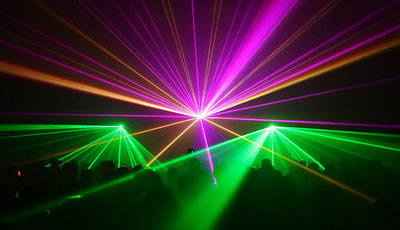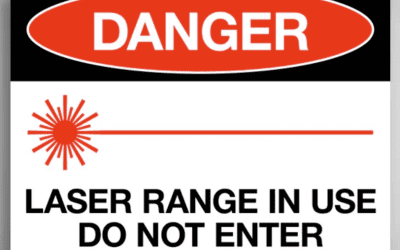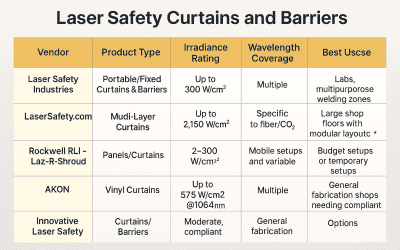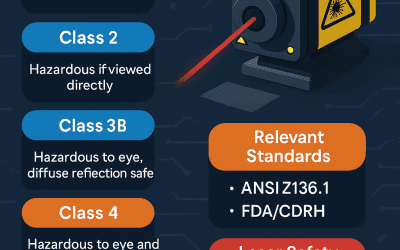3-Step Checklist for FDA Approval of your Laser Light Show
Laser light shows can be used anywhere for any occasion. Here are some examples of events where laser light shows are used:
- Musical acts
- Corporate events
- Sporting events and game openings
- Trade shows
- Major outdoor events
- Movie premiers
- Audience scanning
Laser beams and projected images can be combined to create exciting 3-D effects. Laser light show software is typically used to synchronize visual effects with music or vocal performances.
Lasers used in laser light shows are typically Class 3B or Class 4, high power lasers. These lasers can be hazardous to the skin and eyes under direct exposure. They can also pose a fire hazard due to the high power output.
It is important to have proper safety protocols in place when using lasers in light shows. These protocols should include the use of personal protective equipment (PPE), such as laser safety goggles, and the implementation of control measures, such as beam stops and barriers.
The FDA/CDRH Federal Laser Product Performance Standard (FLPPS) regulates the manufacture of lasers and laser light shows. 1 The standard does not contain specific design specifications, but is a conceptual, performance standard that the designer of laser products must consider. 2 The intent is to ensure laser product safety.
Light Show Safety
Three primary light show safety issues to keep in mind are: Audience safety, Aircraft safety (for outdoor shows) and Regulatory compliance.
Lasers used in light shows can range from Class II to Class IIIa, and to Class IIIb and even Class IV (see [9] and [10]). But safety is paramount for any laser projector. The FDA requires permission to deviate from a product’s original form. This is called a variance and requires additional steps to assure safety.
The FDA’s laser light show safety rules are:
- Before Class IIIb or Class IV lasers are sold, used in performances or otherwise introduced into commerce for demonstration or entertainment purposes, manufacturers must have an approved variance from FDA.
- Laser manufacturers include people who make laser products and people who receive compensation to design, assemble or modify a laser projector and/or light show.
Who is a manufacturer? A musical group or others who assemble light shows are considered manufacturers even if they only design the show or change the purpose of a laser without altering the device in any way. This is what creates the need for the variance, the laser’s intended use; from the FDA Variance Package ([6], link below): “The act of assembly of a laser light show using a previously manufactured laser or laser product results in the creation or manufacture of a ‘new’ product…”
FDA Guidelines for Laser Light Show Approval
If you want to create a laser light show, you must follow the FDA’s procedures.
Laser products used for light show purposes are limited to Class IIIa laser projectors with 5 milliwatts of power and a visible wavelength range of 400-710 nanometers.
If your laser light show uses Class IIIb and IV lasers, here are the 4 FDA reports you’ll need to file:
- Product Report [2] – FDA Form 3632: https://www.fda.gov/media/72593/download
- Laser Light Show Report [3] – FDA Form 3640: https://www.fda.gov/media/72658/download
- Application for Variance [4] – FDA Form 3147: https://www.fda.gov/media/72256/download
- Annual Report [5] – FDA Form 3636: https://www.fda.gov/media/72606/download
The FDA also provides a cover sheet for your Variance Package [6] summarizing the reports and when they are needed based on your role as a manufacturer (again, see that note above) or distributor: https://www.fda.gov/media/142493/download
Three Step Checklist
1. Laser Product Report: Document specifics of each laser product model/family
2. Laser Light Show Report: Provide show details
3. Application for Variance: Prepare and submit
Step one: document the specifics of each laser product model or family you intend to use in the Laser Product Report.
Laser Product Report Preparation:
- Manufacturer name, address, contact
- Any importing Agent information
- Names, brand names, model numbers and model family designations
- Previous modification(s), if any
- Other unmodified certified laser products
- Any non-certified laser products
- Any removable laser systems [1040.10(c)(2)]
- Additional information concerning the product power, rating or classification
Step two: Provide the details of the show in the Laser Light Show Report.
Laser Light Show Report show details:
- Manufacturer and responsible person for light show
- Any importing agent
- Per 21 CFR 1002, is this a new laser light show report or supplemental report?
- If supplemental, provide original report information
- Light show or display name
- Locations, dates and times
- Include a copy of variance request or approval
- Projection equipment manufacturer, model and CDRH number
- Types of venues
- Indicate if one time or tour
- Describe light show effects to be used
- Diagrams and drawings of venue including
- Location of projector or other devices
- Direct and reflected laser beam path
- Laser radiation levels
- Minimum separations of laser beam
- Any direct or reflected beams into audience or performers
- Attach drawings
- Describe radiation levels and provide calculations
Also ask yourself these questions:
- Are you doing audience scanning?
- Can anyone see the laser beams?
- Are any above Class I or II?
- Is the show under continuous operator control?
- Does the operator have other duties during the show?
- Can the operator see the audience and all beam paths?
- Is there an assistant providing surveillance?
- If so, identify each person and their role
- Is your laser operator qualified and how?
- Is there another designated responsible person?
- What is their experience and training?
- Is there easy to access controls to stop the show in case of an emergency?
- Where are the controls located?
- Do you have written procedures?
- Are written records of these procedures kept?
- What other regulatory procedures will be followed?
- Is regulatory notification necessary?
Third, prepare the Application for Variance.
To get a variance, you’ll need to know:
- What type of product needs a variance?
- Will projectors will be used?
- Where will the light show be staged?
- Will the light show be used once or on a tour basis? How long will the tour run?
- How long will the product be in use?
- What type of laser effects will you use?
- What is the deviation or variance from the applicable standard you need?
- Why is the variance necessary?
- What type of safety measures will you follow?
Laser light show operators must be properly trained to ensure safety. The high-powered lasers used in light shows create exciting powerful displays. But you must also remember that they can cause eye damage and skin burns to people if exposed to the direct beams. And they may also pose hazards to aircraft if laser beams shine directly onto a plane from the venue.
Laser Safety is Important
Protecting your employees and customers from laser hazards is a top priority for your business. At Laser Safety Certification, we are dedicated to promoting laser safety through our comprehensive laser safety certification training programs. Enroll your company in our certification courses today and empower your team with the knowledge and skills to use lasers safely and effectively.
Our courses cover a wide range of laser safety topics, including:
- Laser Basics
- Laser Hazards
- Laser Safety Officer (LSO) Responsibilities
- Laser Safety Standards and Regulations
- ANSI Z136.1
- ANSI Z136.3
- OSHA Guidelines
- Laser Classification
- Control Measures
- Personal Protective Equipment (PPE)
- Non-Beam Hazards
- Eye and Skin Exposure
- Maximum Permissible Exposure (MPE)
- Nominal Hazard Zone (NHZ)
As the Laser Safety Officer (LSO), you play a critical role in establishing and maintaining a safe working environment. Our courses provide the necessary training and certification to help you fulfill your responsibilities and ensure the well-being of your team and customers.
In addition to our courses, we offer laser safety kits that contain essential tools and resources for administering a successful laser safety program. These kits, combined with our training, will equip you with everything you need to implement proper laser safety protocols and protect your employees and customers.
Enroll your company today and take the first step towards creating a laser-safe workplace. Together, let’s prioritize safety and ensure the responsible use of lasers in your business.
References
[1] FDA Laser Light Show page: https://www.fda.gov/radiation-emitting-products/home-business-and-entertainment-products/laser-light-shows
[2] Product Report – FDA Form 3632: https://www.fda.gov/media/72593/download
[3] Laser Light Show Report – FDA Form 3640: https://www.fda.gov/media/72658/download
[4] Application for Variance – FDA Form 3147: https://www.fda.gov/media/72256/download
[5] Annual Report – FDA Form 3636: https://www.fda.gov/media/72606/download
[6] FDA Variance Package cover sheet: https://www.fda.gov/media/142493/download
[7] Laser Light Show Projectors Explained (a “How do they work” guide): https://lasershowprojector.com/blogs/education/laser-show-projectors-explained
[8] Selecting the right laser light show source (downloadable PDF): https://www.laserworld.com/en/lasersources.html
[9] LaserSafetyFacts Laser Classes: https://www.lasersafetyfacts.com/classes-menu.html
[10] Nation Laser Company Laser Classification: https://nationallaser.com/laser-classification-safety/




